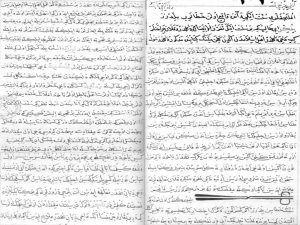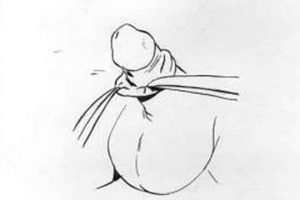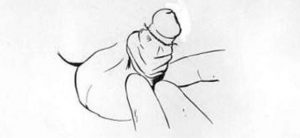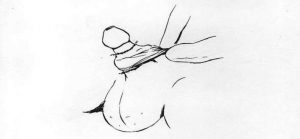UROLOGY IN HISTORY
Atilla Senayli, Murat Aksu, Munir Atalar
Vol. 11 | No. 03 | May – June 2014 | 1731-1734
Purpose: Circumcision is one of the historical surgical procedures. Some sources throughout the history contain various definitions about different circumcision methods. we described the details of the method, and aimed to remind the possibility of contemporary usage.
Materials and Methods: We compared circumcision chapters of Sabuncuoglu and Zahrawi to explain the historical origin of Sabuncuoglu’s favorite circumcision method.
Results: We found a method which might be summarized as “knotting with rope technique” in one of historical textbooks named as Cerrahiyyetul Haniyye (Imperial Surgery) written by Serefeddin Sabuncuoğlu (1385-1468?) in 1465.
Conclusion: This circumcision method is not used currently. In addition this method has not been defined in the history of medical literature yet.
Keywords: circumcision; humans; history, 18th century; Serefeddin Sabuncuoglu.
INTRODUCTION
Circumcision is one of the ancient surgical procedures performed in all over the world.(1) There are old sources to obtain information about the history of circumcision and different ancient circumcision methods. One of the sources is a book written by Serefeddin Sabuncuoğlu (1385-1468?) in 1465. He wrote Cerrahiyyetul Haniyye (Imperial Surgery) referring to Ebu Kasim-ul Zahravi’s (Albucasis) Textbook of Surgery.(2) We read a special chapter of Cerrahiyyetul Haniyye while evaluating the historical information for circumcision. Meanwhile, we found out that Sabuncuoğlu’s favorite circumcision type was not in contemporary use.
In this study, we aimed to put forward this forgotten circumcision method by comparing with some contemporary methods. We suppose that reminding the procedure may be clinically useful.
MATERIALS AND METHODS
We compared circumcision chapters of Sabuncuoglu and Zahrawi to demonstrate the historical origin of Sabuncuoglu’s favorite circumcision method before the study. Bayat’s dissertation has Turkish translation of Zahrawi’s circumcision chapter, and we evaluated the related section.(3) We found that the chapters were totally same. The method was originated from Zahrawi’s textbook. To perform a methodological evaluation for the circumcision method, we used Sabuncuoglu’s textbook. For this purpose, 57th chapter of Cerrahiyyetul Haniyye (Imperial Surgery) that was prepared by Uzel in Latin alphabet was evaluated.(4) Original chapter in Uzel’s book was revealed in Figure 1. The chapter was translated in English during the study. We draw the pictures of aforementioned surgery to clarify the translated chapter. After the translation and illustrations, we discussed the explanations in the light of the literature, and evaluated some controversies.
RESULTS
The Translation
Chapter 57
This is a chapter about the circumcision of the children and informs for the mistakes on this subject.
Investigator
Don’t consider the circumcision as tearing the adhesion or wound after injury. The book of the nations before Islam did not deal with this subject because it was not written in their religious believes. The fact, circumcision, is only in question of Islam.
I felt responsible that I had to put forward a circumcision method which was performed easily, successfully and healthy. We had seen persons circumcised with razor, scissor or bastinado, some persons cut after knotting with rope or cut with nails. In fact, we experienced; the best and easiest was the knotting with a rope and cut with scissor. Because, if you use razor, the prepuce would be two layers and only upper layer would be cut and lower layer would left. Therefore, you have to cut prepuce again as a second stage. If bastinado was used without attention, glans penis would pass through the bastinado and cut by mistake. There was a danger with nail circumcision because if the mould turned away by mistake, operation would be wrong or penile skin would be shortened after the operation.
In our experience we determined that some children born without a need of circumcision. We experienced advantages about circumcision with scissor. However, scissor has to be functional and adequate in this procedure for cutting and the switch lever of the scissor must be in the middle of the scissor. Scissor has to be curved and both side must be just enough and must cut at first attempt. Binding the skin to get both layers together makes the work correct. At first, you will not scare the boy you will circumcised. You will say something that makes child happy. By hiding the cutting instrument in your clothes or under your foot, you should protect the child from the fear caused by the instrument. Then let the child stand up, release child’s prepuce from glans and urethra totally. You have to clean the smegma under the prepuce. You have to tear the prepuce, mark the cutting line with silk rope and fasten (Figures 2 and 3). Tie another silk rope below the first silk rope, then hold the prepuce with your two fingers and pull down (Figure 4), cut among these two silk ropes (Figure 5). Then, immediately raise the penile skin, you have to take urethra out, and then let an amount of bleeding for preventing swelling and for aeration. You have to clean the blood with a wet cloth and have to spread dried pumpkin cinders. I experienced dried pumpkin cinders and this is the best or you have to spread mill dust, which is good, too. You have to apply yolk mixed with rose oil, which is cooked in rose water with eye brass. It has to be on the wound for a day. Then, you have to manage with other drugs to heal. You can see the scissors shapes aforementioned and you can understand what do they like (Figure 1).

Figure 1. Original circumcision chapter in Uzel’s book.
States for Circumcision Errors
If part of the inner layer of the prepuce escaped from the mould during circumcision, cut immediately either with a nail or a scissor or you have to tear with your nail to left it above and if you are unsuccessful, you have to leave it till the end of swelling. After the swelling was absorbed, peel the remaining prepuce posterior. After this, cut with any method you want. You have to protect urethral mea. If it is not cut with these, you have to medicate with healing drugs like eye brass. If prepuce is cut too much and skin is not hold above, that is not important and you have to heal, God willing.
DISCUSSION
Surgical excision of the foreskin on the glans is simply named as circumcision.(5) It is one of the oldest procedures.(6) Investigations on Egyptian mummies revealed circumcision evidences.(6) Pre-Islamic and early Islamic documentations also demonstrated complications related to circumcisions.(7) Nevertheless, circumcision is a safe surgical procedure in experienced hands.(5)

Figure 2. “You have to tear the prepuce…”

Figure 3. “… mark the cutting line with silk rope and fasten.”
All over the world, the estimated frequency circumcision is 1 in 25 min.(5) In USA, 1.2 million newborn are circumcised each year.(8) As it is mentioned before, the aim of circumcision is prepuce excision.(6) Different methods and equipment may be used for this purpose.(7) Wood cutter, razor, various clamps or surgical techniques were used.(5-7,9) There are different clamps called Plastibell, Gomco, Shang ring and Mogen.(5,8-10) The effectiveness of this clamp is controversial.(5) For example, in plastibell procedures need 2-3 days to complete the circumcision, and sometimes, suture must be placed around the foreskin to finalize the circumcision.(8)

Figure 4. “Tie another silk rope below the first silk rope, then hold the prepuce with your two finger and pull down.”
Also preputial plasty is suggested as an alternative surgery for circumcision.(6) Also, there are many surgical methods. Sleeve resection is the most similar method with Sabuncuoglu’s circumcision.

Figure 5. “…cut among these two silk ropes.”
In sleeve resection, prepuce is not squeezed as in Sabuncuoglu’s method, and prepuce is excised as a free flap.(11) The main difference between sleeve resection and the historical technique is; tightening the prepuce within two silk ropes. We realize that Sabuncuoglu’s favorite circumcision method is not present in English and Turkish literature as a contemporary surgical method. Sabuncuoglu’s described different methods for circumcision in the textbook. He stated different types of devices for these circumcision methods like bastinado, razor, scissor, and he also described equipment for nail circumcision in the first section of the circumcision chapter. For practitioners, he emphasized in the second part of the circumcision chapter that cutting with scissor after the knitting with rope technique will be better. In this technique, the penile shaft was bonded with a silk rope. Then the prepuce was torn on this silk rope. After this, another silk rope was bonded distally. As a result the prepuce squeezed between these ropes and he performed the circumcision adequately.
The main purpose for circumcision is best cosmesis, lower morbidity, optimum attention to sepsis and hemostasis.(6) Post-operative treatments for circumcision were not defined in details in Cerrahiyyetul Haniyye. For ancient books, anesthesia of circumcision was not reported, and ashes were used to stop hemorrhage.(7) Incomplete excision is the most seen complication.(7) Phimosis and concealed penis can be seen subsequently.(7) Different techniques are developed to minimize these complications, and to simplify the procedure.(10)
The main purpose of Sabuncuoglu was performing an easy and cosmetic procedure. Our study tried to remind this historical circumcision method. However, we did not aim to evaluate the availability of the method for contemporary clinical usage. Nevertheless, incisional complications like urethra trauma minimal bleeding with inadequately fixed ropes may be seen. Surgical comfort and suturing may be better.
CONCLUSION
There are many methods for circumcision. However, the circumcision technique emphasized in Sabuncuoglu’s textbook hasn’t been in use currently. We are pleased to reveal this old and forgotten technique. It may be modified for contemporary usage. This experience shows us that history will always enlighten the future. Same circumstances may be possible for other surgical methodological trials. Devices, suture techniques or methods may be used to brighten the contemporary surgical procedures.
CONFLICT OF INTEREST
None declared.
REFERENCES
1. Basar H, Yılmaz E, Başar MM, Batislam E, Tuglu D. Window technique on circumcision. Int Urol Nephrol. 2006;38:599-601.
2. Keskil S and Sabuncuoglu H. Endoscopy in the 15th century. Minim Invas Neurosurg. 2002;45:45-6.
3. Bayat AH. Tarihte Sünnet ve Tarihimizde Sünnet Şenlikleri (Dissertation). İzmir, Ege Üniversitesi Tıp Tarihi ve Deontoloji Kürsüsü, 1979.
4. Uzel I Serefeddin Sabucuoglu Cerrahiyyetul Haniyye. Ankara: Türk Tarih Kurumu Yayınları III. Dizi-1992; Sa. 15a
5. Morris BJ. Why circumcision is a biomedical imperative for the 21st century. Bio Essays. 2007;29:1147-58.
6. Williams N, Kapila L. Complications of circumcision. Br J Surg. 1993;80:1231-6.
7. Rizvi SAH, Naqvi SAA, Hussain M. Hasan AS. Religious circumcision: a Muslim view. BJU Int. 1999;83:13-6.
8. Kurtis PS, DeSilva HM, Bernstein BA, Malakh L, Schechter NL. A Comparison of the Mogen and Gomco Clamps in Combination with Dorsal Penile Nerve Block in Minimizing the Pain of Neonatal Circumcision. Pediatrics. 1999;103:E23.
9. Task Force on Circumcision. Male Circumcision. Pediatrics. 2012;130:e756.
10. Barone MA, Ndede F, Li PS, et al. The Shang Ring Device for Adult Male Circumcision: A Proof of Concept Study in Kenya. J Acquir Immune Defic Syndr. 2011;57:e7-e12.
11. O’Sullıvan DC and Heal MR. Powell Circumcision: how do urologists do it? Br J Urol. 1996;78:265-70.
Department of Pediatric Surgery, Children’s Health and Disease Hematology-Oncology Education and Research Hospital, Ankara
Department of the History of Medicine and Ethics, School of Medicine, Izmir University, Izmir
Department of History, Faculty of Science and Fine Arts, Gaziosmanpasa University, Tokat
Corresponding Author:
Tel: +90 506 6917990
Fax: +90 312 347 1330
E-mail: atillasenayli@gmail.com
Received February 2014 Accepted April 2014
UROLOGY IN HISTORY
Atilla Senayli, Murat Aksu, Munir Atalar
Vol. 11 | No. 03 | May – June 2014 | 1731-1734
Purpose: Circumcision is one of the historical surgical procedures. Some sources throughout the history contain various definitions about different circumcision methods. we described the details of the method, and aimed to remind the possibility of contemporary usage.
Materials and Methods: We compared circumcision chapters of Sabuncuoglu and Zahrawi to explain the historical origin of Sabuncuoglu’s favorite circumcision method.
Results: We found a method which might be summarized as “knotting with rope technique” in one of historical textbooks named as Cerrahiyyetul Haniyye (Imperial Surgery) written by Serefeddin Sabuncuoğlu (1385-1468?) in 1465.
Conclusion: This circumcision method is not used currently. In addition this method has not been defined in the history of medical literature yet.
Keywords: circumcision; humans; history, 18th century; Serefeddin Sabuncuoglu.
INTRODUCTION
Circumcision is one of the ancient surgical procedures performed in all over the world.(1) There are old sources to obtain information about the history of circumcision and different ancient circumcision methods. One of the sources is a book written by Serefeddin Sabuncuoğlu (1385-1468?) in 1465. He wrote Cerrahiyyetul Haniyye (Imperial Surgery) referring to Ebu Kasim-ul Zahravi’s (Albucasis) Textbook of Surgery.(2) We read a special chapter of Cerrahiyyetul Haniyye while evaluating the historical information for circumcision. Meanwhile, we found out that Sabuncuoğlu’s favorite circumcision type was not in contemporary use.
In this study, we aimed to put forward this forgotten circumcision method by comparing with some contemporary methods. We suppose that reminding the procedure may be clinically useful.
MATERIALS AND METHODS
We compared circumcision chapters of Sabuncuoglu and Zahrawi to demonstrate the historical origin of Sabuncuoglu’s favorite circumcision method before the study. Bayat’s dissertation has Turkish translation of Zahrawi’s circumcision chapter, and we evaluated the related section.(3) We found that the chapters were totally same. The method was originated from Zahrawi’s textbook. To perform a methodological evaluation for the circumcision method, we used Sabuncuoglu’s textbook. For this purpose, 57th chapter of Cerrahiyyetul Haniyye (Imperial Surgery) that was prepared by Uzel in Latin alphabet was evaluated.(4) Original chapter in Uzel’s book was revealed in Figure 1. The chapter was translated in English during the study. We draw the pictures of aforementioned surgery to clarify the translated chapter. After the translation and illustrations, we discussed the explanations in the light of the literature, and evaluated some controversies.
RESULTS
The Translation
Chapter 57
This is a chapter about the circumcision of the children and informs for the mistakes on this subject.
Investigator
Don’t consider the circumcision as tearing the adhesion or wound after injury. The book of the nations before Islam did not deal with this subject because it was not written in their religious believes. The fact, circumcision, is only in question of Islam.
I felt responsible that I had to put forward a circumcision method which was performed easily, successfully and healthy. We had seen persons circumcised with razor, scissor or bastinado, some persons cut after knotting with rope or cut with nails. In fact, we experienced; the best and easiest was the knotting with a rope and cut with scissor. Because, if you use razor, the prepuce would be two layers and only upper layer would be cut and lower layer would left. Therefore, you have to cut prepuce again as a second stage. If bastinado was used without attention, glans penis would pass through the bastinado and cut by mistake. There was a danger with nail circumcision because if the mould turned away by mistake, operation would be wrong or penile skin would be shortened after the operation.
In our experience we determined that some children born without a need of circumcision. We experienced advantages about circumcision with scissor. However, scissor has to be functional and adequate in this procedure for cutting and the switch lever of the scissor must be in the middle of the scissor. Scissor has to be curved and both side must be just enough and must cut at first attempt. Binding the skin to get both layers together makes the work correct. At first, you will not scare the boy you will circumcised. You will say something that makes child happy. By hiding the cutting instrument in your clothes or under your foot, you should protect the child from the fear caused by the instrument. Then let the child stand up, release child’s prepuce from glans and urethra totally. You have to clean the smegma under the prepuce. You have to tear the prepuce, mark the cutting line with silk rope and fasten (Figures 2 and 3). Tie another silk rope below the first silk rope, then hold the prepuce with your two fingers and pull down (Figure 4), cut among these two silk ropes (Figure 5). Then, immediately raise the penile skin, you have to take urethra out, and then let an amount of bleeding for preventing swelling and for aeration. You have to clean the blood with a wet cloth and have to spread dried pumpkin cinders. I experienced dried pumpkin cinders and this is the best or you have to spread mill dust, which is good, too. You have to apply yolk mixed with rose oil, which is cooked in rose water with eye brass. It has to be on the wound for a day. Then, you have to manage with other drugs to heal. You can see the scissors shapes aforementioned and you can understand what do they like (Figure 1).

Figure 1. Original circumcision chapter in Uzel’s book.
States for Circumcision Errors
If part of the inner layer of the prepuce escaped from the mould during circumcision, cut immediately either with a nail or a scissor or you have to tear with your nail to left it above and if you are unsuccessful, you have to leave it till the end of swelling. After the swelling was absorbed, peel the remaining prepuce posterior. After this, cut with any method you want. You have to protect urethral mea. If it is not cut with these, you have to medicate with healing drugs like eye brass. If prepuce is cut too much and skin is not hold above, that is not important and you have to heal, God willing.
DISCUSSION
Surgical excision of the foreskin on the glans is simply named as circumcision.(5) It is one of the oldest procedures.(6) Investigations on Egyptian mummies revealed circumcision evidences.(6) Pre-Islamic and early Islamic documentations also demonstrated complications related to circumcisions.(7) Nevertheless, circumcision is a safe surgical procedure in experienced hands.(5)

Figure 2. “You have to tear the prepuce…”

Figure 3. “… mark the cutting line with silk rope and fasten.”
All over the world, the estimated frequency circumcision is 1 in 25 min.(5) In USA, 1.2 million newborn are circumcised each year.(8) As it is mentioned before, the aim of circumcision is prepuce excision.(6) Different methods and equipment may be used for this purpose.(7) Wood cutter, razor, various clamps or surgical techniques were used.(5-7,9) There are different clamps called Plastibell, Gomco, Shang ring and Mogen.(5,8-10) The effectiveness of this clamp is controversial.(5) For example, in plastibell procedures need 2-3 days to complete the circumcision, and sometimes, suture must be placed around the foreskin to finalize the circumcision.(8)

Figure 4. “Tie another silk rope below the first silk rope, then hold the prepuce with your two finger and pull down.”
Also preputial plasty is suggested as an alternative surgery for circumcision.(6) Also, there are many surgical methods. Sleeve resection is the most similar method with Sabuncuoglu’s circumcision.

Figure 5. “…cut among these two silk ropes.”
In sleeve resection, prepuce is not squeezed as in Sabuncuoglu’s method, and prepuce is excised as a free flap.(11) The main difference between sleeve resection and the historical technique is; tightening the prepuce within two silk ropes. We realize that Sabuncuoglu’s favorite circumcision method is not present in English and Turkish literature as a contemporary surgical method. Sabuncuoglu’s described different methods for circumcision in the textbook. He stated different types of devices for these circumcision methods like bastinado, razor, scissor, and he also described equipment for nail circumcision in the first section of the circumcision chapter. For practitioners, he emphasized in the second part of the circumcision chapter that cutting with scissor after the knitting with rope technique will be better. In this technique, the penile shaft was bonded with a silk rope. Then the prepuce was torn on this silk rope. After this, another silk rope was bonded distally. As a result the prepuce squeezed between these ropes and he performed the circumcision adequately.
The main purpose for circumcision is best cosmesis, lower morbidity, optimum attention to sepsis and hemostasis.(6) Post-operative treatments for circumcision were not defined in details in Cerrahiyyetul Haniyye. For ancient books, anesthesia of circumcision was not reported, and ashes were used to stop hemorrhage.(7) Incomplete excision is the most seen complication.(7) Phimosis and concealed penis can be seen subsequently.(7) Different techniques are developed to minimize these complications, and to simplify the procedure.(10)
The main purpose of Sabuncuoglu was performing an easy and cosmetic procedure. Our study tried to remind this historical circumcision method. However, we did not aim to evaluate the availability of the method for contemporary clinical usage. Nevertheless, incisional complications like urethra trauma minimal bleeding with inadequately fixed ropes may be seen. Surgical comfort and suturing may be better.
CONCLUSION
There are many methods for circumcision. However, the circumcision technique emphasized in Sabuncuoglu’s textbook hasn’t been in use currently. We are pleased to reveal this old and forgotten technique. It may be modified for contemporary usage. This experience shows us that history will always enlighten the future. Same circumstances may be possible for other surgical methodological trials. Devices, suture techniques or methods may be used to brighten the contemporary surgical procedures.
CONFLICT OF INTEREST
None declared.
REFERENCES
1. Basar H, Yılmaz E, Başar MM, Batislam E, Tuglu D. Window technique on circumcision. Int Urol Nephrol. 2006;38:599-601.
2. Keskil S and Sabuncuoglu H. Endoscopy in the 15th century. Minim Invas Neurosurg. 2002;45:45-6.
3. Bayat AH. Tarihte Sünnet ve Tarihimizde Sünnet Şenlikleri (Dissertation). İzmir, Ege Üniversitesi Tıp Tarihi ve Deontoloji Kürsüsü, 1979.
4. Uzel I Serefeddin Sabucuoglu Cerrahiyyetul Haniyye. Ankara: Türk Tarih Kurumu Yayınları III. Dizi-1992; Sa. 15a
5. Morris BJ. Why circumcision is a biomedical imperative for the 21st century. Bio Essays. 2007;29:1147-58.
6. Williams N, Kapila L. Complications of circumcision. Br J Surg. 1993;80:1231-6.
7. Rizvi SAH, Naqvi SAA, Hussain M. Hasan AS. Religious circumcision: a Muslim view. BJU Int. 1999;83:13-6.
8. Kurtis PS, DeSilva HM, Bernstein BA, Malakh L, Schechter NL. A Comparison of the Mogen and Gomco Clamps in Combination with Dorsal Penile Nerve Block in Minimizing the Pain of Neonatal Circumcision. Pediatrics. 1999;103:E23.
9. Task Force on Circumcision. Male Circumcision. Pediatrics. 2012;130:e756.
10. Barone MA, Ndede F, Li PS, et al. The Shang Ring Device for Adult Male Circumcision: A Proof of Concept Study in Kenya. J Acquir Immune Defic Syndr. 2011;57:e7-e12.
11. O’Sullıvan DC and Heal MR. Powell Circumcision: how do urologists do it? Br J Urol. 1996;78:265-70.
Department of Pediatric Surgery, Children’s Health and Disease Hematology-Oncology Education and Research Hospital, Ankara
Department of the History of Medicine and Ethics, School of Medicine, Izmir University, Izmir
Department of History, Faculty of Science and Fine Arts, Gaziosmanpasa University, Tokat
Corresponding Author:
Tel: +90 506 6917990
Fax: +90 312 347 1330
E-mail: atillasenayli@gmail.com
Received February 2014 Accepted April 2014

